I know that during the primary fermentation that the temperature should be around 70* or so depending on the beer. After the primary fermenting is done and I rack to a secondary carboy does it matter as much what the temperature in the room is at? I built a myself this smoker last fall and I have a control monitor that will keep the temperature within +/-1* of the set temperature. I am going to be using it to keep the primary batch fermenting at 70* but when I rack to the secondary can I move the secondary to the garage where I'll eventually do the bottling or should I leave it in the smoker unit at 70*?
thanks,
jared

thanks,
jared



